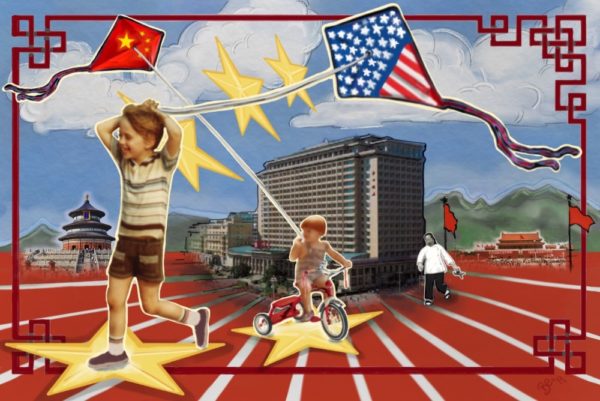
Eunice San Miguel, 110 Infusions, KIN.
At their best, Zócalo’s essays induce the same broad thinking as the most engrossing puzzles. A puzzle, by its very nature, forces us to confront tricky questions while resolving where we fit in a bigger picture.
In the midst of a confounding year, Zócalo’s contributors were able to do just that—piecing together answers to surprising questions from history, art, and science on our pages.
How was the idea of belief transformed in the 17th century? Why do we all remember that Lizzie Borden “gave her father 40 whacks”? How did an increasingly deaf Beethoven make music? Why does silence retain such power? How can a physician’s assistant maintain an innovative health clinic in a small California town?
Needless to say, the task of picking our favorites among the hundreds of essays we publish each year was no easy task.
But in the end, the 17 essays below are distinguished by the fact that they still have us pondering—long after we first published them.
The Heartbreaking Love Letters That Spurred an Ohio Blacksmith to Join John Brown’s Raid
Former Washington Post reporter and editor Eugene L. Meyer describes the desperate missives from Dangerfield Newby’s enslaved wife and how they inspired his participation in the abolitionist rebellion.
We Put the Ultrasound Machine in the Local Pharmacy
Physician assistant Luz Garcia explains how she established an unusual family medical clinic in the heart of a small town of farmworkers in California’s Salinas Valley.
Why America’s First Saint Stopped Trying to Convert Her Neighbors to Catholocism
Arizona State University historian of religion Catherine O’Donnell examines the lasting lessons of the life of Elizabeth Seton, the first U.S.-born American citizen to be made a saint in the Roman Catholic Church.
Picturing Blood and Kinship
Artist and illustrator Eunice San Miguel recovered from cancer at a young age—and then started painting her relationship to her family and to her body in profoundly new ways.
How the Survivor of a 1609 Shipwreck Brought Democracy to America
Joseph Kelly, a professor of English at the College of Charleston, brings to life the story of Stephen Hopkins, a colonist at both Jamestown and Plymouth, who endured great hardship to propose a government based on the consent of the governed.
Why Beethoven’s Loss of Hearing Added New Dimensions to His Music
Baylor University musicologist Robin Wallace, drawing in part on the experience of his late wife, who was profoundly deaf, explains how Beethoven’s hearing loss was the source of the composer’s inspiration to create a novel sonic universe.

Washington Restaurant with bicycles in front. Courtesy of the Museum of Riverside, Riverside, California.
When Police Clamped Down on Southern California’s Japanese-American Bicycling Craze
UCLA historian and spatial theorist Genevieve Carpio recounts the turn-of-the-century bicycle craze among Japanese Americans in Southern California—and how authorities eventually used surveillance to limit their mobility and enforce racial separation.
Why Molokai Is the Least Developed of Hawai‘i’s Islands
Urban and environmental policy writer Wade Graham demonstrates how Molokai’s persistent struggles reflect the difficulties of similarly situated places the world over.
The Small-Town West Virginia Bookstore That Helped Me Survive My Terrible Childhood
Journalist and Zócalo editor-at-large Andrea Pitzer recalls how the books in her grandparents’ store in Parkersburg, West Virginia, gave her a way to understand cruelty and escape her troubles.
What Giacometti’s Obsession With the Color Gray Really Meant
Paris-based teacher of art and film Frances Guerin shows how the 20th-century Swiss artist Alberto Giacometti, in turning from sculpture to painting, used color to represent his existential yearnings.
Native Hawaiian Returns Home
Freelance writer Stephanie Launiu explains why it was so hard to feel accepted in her native Hawai‘i when her family moved back after 30 years in California.
Religious Belief Was a 17th-Century Invention
University of California Berkeley historian Ethan Shagan offers a revised history of atheism that demonstrates how faith became a personal choice.
The Radical Meaning of Silence
University of Oxford English literature professor Kate McLoughlin demonstrates the power of wordless glances and subtle gestures in our very noisy world.

Illustration by Be Boggs.
What Communist China Taught a 6-Year-Old American Boy
Connecting California columnist Joe Mathews’s parents were among the first American journalists to move to Beijing in 1979. Growing up with Tiananmen Square as his playground, 6-year-old Joe learned lasting lessons in diplomacy, authority, and democracy.
Why Rising Venezuelan Nostalgia Makes It All the Harder to Imagine a Future
Venezuela-based professor and Zócalo contributing editor José González Vargas details the rise of nostalgia in a country struggling to cope with an uncertain present and an unknown future.
How Did 19th-Century Axe Murderer Lizzie Borden Become a Household Name?
New England historian Joseph Conforti explains how wealthy Yankee Lizzie Borden exploited anti-immigrant prejudice to get away with murder, thus creating a controversy that made her a household name.
Was Leland Stanford a ‘Magnanimous’ Philanthropist or a ‘Thief, Liar, and Bigot?’
Historian and long-time investigative reporter Roland de Wolk explores how the railroad magnate, California governor and putative philanthropist Leland Stanford helped establish America’s infamously disruptive, get-rich-quick, ill-mannered, entrepreneurial culture.




Send A Letter To the Editors